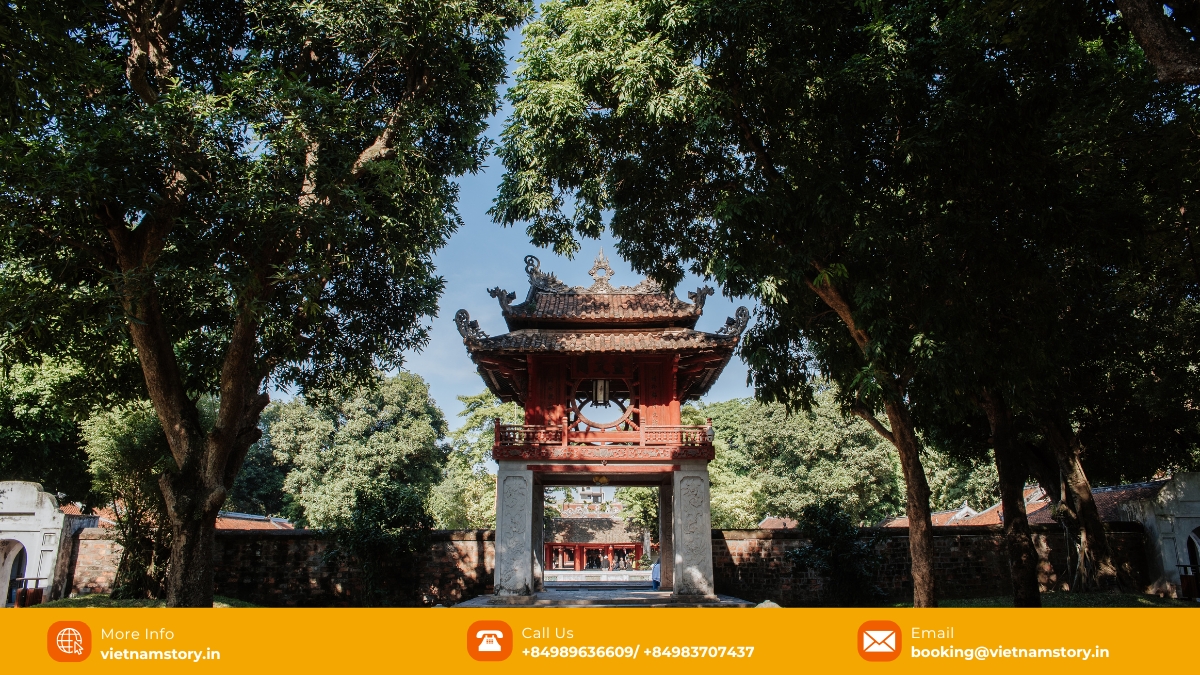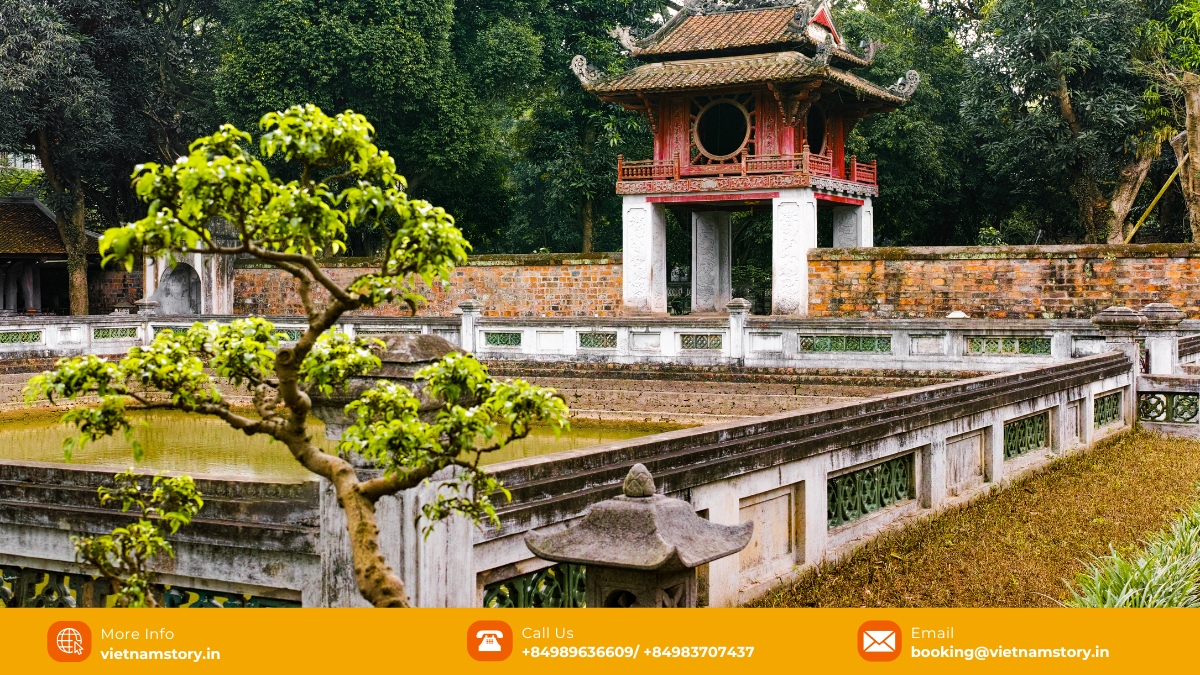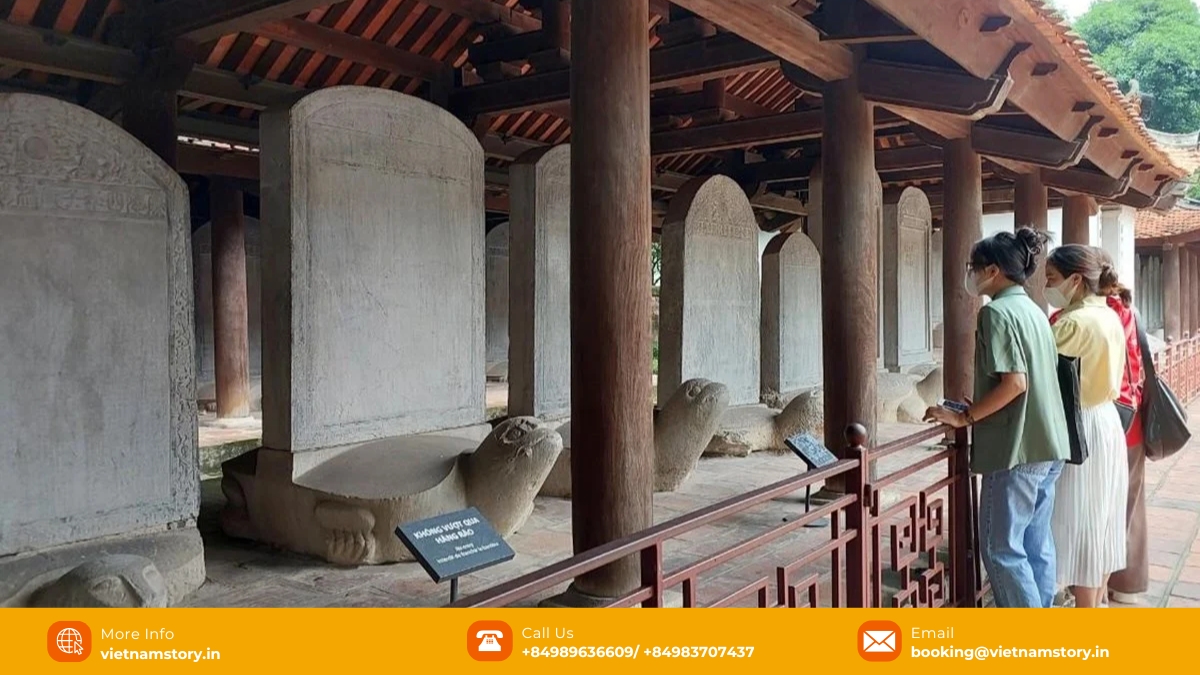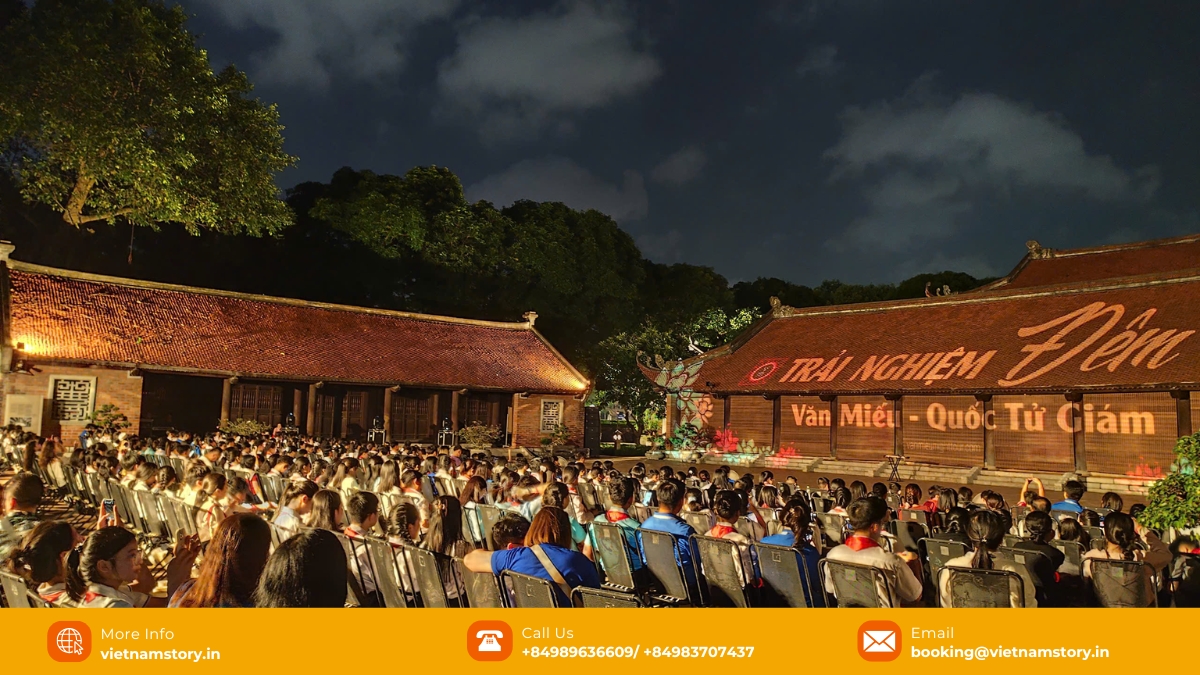Looking for must-see historical sites in Hanoi, Vietnam? Planning your trip and wondering which cultural gems offer a deep dive into the country’s heritage? Hanoi’s Temple of Literature, known locally as Van Mieu – Quoc Tu Giam, is exactly that place. More than just an ancient monument, it’s a powerful symbol of education and scholarship, representing Vietnam’s first national university and a centuries-old reverence for learning that still resonates today. Visiting this well-preserved complex offers a tranquil escape and a fascinating look into the values that shaped the nation. Let’s explore why this site is so important and what you can expect when you visit.
Discovering Hanoi’s Temple of Literature (Van Mieu – Quoc Tu Giam)
Hanoi’s Temple of Literature, officially known as Van Mieu – Quoc Tu Giam, is a truly significant historical site and a premier cultural site in Vietnam. It serves a unique dual purpose: it is a dedicated religious site established to honor the revered sage Confucius and other esteemed scholars, and it fundamentally operates as a monument to the enduring importance of education and scholarship in Vietnamese society. This is vividly illustrated by its dual identity: Van Mieu represents the temple aspect, while Quoc Tu Giam signifies the Imperial Academy, which holds the remarkable distinction of being Vietnam’s first national university. This inherent relationship between the temple and the academy perfectly demonstrates the deep historical link between Confucian values and the persistent pursuit of knowledge in this region.
As one of the finest surviving examples of traditional Vietnamese architecture in Hanoi, this complex offers visitors a tangible connection to the aesthetic and building techniques of the past. A particularly significant element, adding immense historical and cultural value, is the collection of 82 Doctor’s stelae (Bia Tiến Sĩ). These entities are incredibly valuable, being set upon the backs of stone turtles and meticulously recording the names and achievements of those who successfully passed the rigorous royal examinations conducted between 1442 and 1779. Their profound historical and cultural importance is globally recognized, earning them the prestigious UNESCO World Documentary Heritage status (1).

The Temple of Literature is defined is undeniably a vital historical site and a significant cultural site. It served as a groundbreaking former educational institution, holding the unique status of being the first university in Vietnam. While dedicated to honoring Confucius, it functions as a specific type of religious site. Finally, its design, layout, and construction highlight its nature as an extensive architectural complex.
The complex is home to that remarkable collection of 82 stone stelae, each mounted on a stone turtle and inscribed with the names of successful scholars – this collection being the specific element recognized as UNESCO World Documentary Heritage. Furthermore, the iconic Khue Van Cac pavilion, a striking architectural entity located within the temple grounds, is not just a beautiful structure but also a widely recognized symbol of Hanoi, a connection so strong that this pavilion is famously featured on the 100,000 Vietnamese Dong banknote.
The Deep History of the Temple of Literature Hanoi
The history of Hanoi’s Temple of Literature is deeply intertwined with the development of education in Vietnam. It was initially established in 1070 under the Ly Dynasty by Emperor Ly Thanh Tong. His purpose was noble: to create a place to worship Confucius, the revered sage, along with other scholars and sages, thereby promoting Confucian principles which greatly influenced Vietnamese society.
Just six years later, in 1076, Emperor Ly Thanh Tong’s son, King Ly Nhan Tong, took this vision a step further by founding the Imperial Academy (Quoc Tu Giam) within the temple complex. This was Vietnam’s first university, initially reserved for the royal family and high-ranking mandarins’ children.
The curriculum at the Imperial Academy was heavily based on Confucianism, focusing on ethics, philosophy, literature, and governance. This emphasis on rigorous scholarship and moral conduct remained central for centuries. In 1253, under King Tran Thai Tong, the academy opened its doors to exceptionally talented commoners, making education more accessible and highlighting the value placed on merit regardless of birth.
Key figures like Chu Van An, a respected teacher and rector in the 14th century, dedicated his life to education here, and a shrine within the complex honors his contributions. Despite periods of war and change across dynasties, the core function and cultural significance of the Temple of Literature endured, training generations of scholars and contributing to Vietnam’s rich intellectual heritage. It remains a powerful testament to the country’s long-standing commitment to learning.

Architectural Beauty: Exploring the Courtyards of Van Mieu Quoc Tu Giam
The layout of the Hanoi’s Temple of Literature is a stunning example of traditional Vietnamese architecture, thoughtfully designed to reflect Confucian principles of harmony, balance, and hierarchy. The complex is structured linearly, guiding visitors through a series of courtyards and buildings that evoke a sense of progression, mirroring the journey of learning and self-improvement.
The design of Van Mieu – Quoc Tu Giam is a masterclass in traditional Vietnamese architecture, laid out symmetrically along a north-south axis. Covering an area of about 54,000 square meters and surrounded by ancient brick walls, the complex is divided into five distinct courtyards, each with its own gate and symbolic meaning. Let’s take a brief walk through them:
- The First Courtyard (Dai Trung Mon / The Great Middle Gate): This is your grand entrance, offering a peaceful, green space. It’s flanked by the Talent Gate and the Virtue Gate, setting the tone for the aspirations of those who passed through seeking knowledge and wisdom.
- The Second Courtyard (Khue Van Cac / The Pavilion of Constellation): Arguably the most iconic structure, the Khue Van Cac is a beautiful pavilion built in 1805. It stands as a prominent symbol of the Hanoi’s Temple of Literature, even appearing on the 100,000 VND banknote you’ll likely use during your trip! Its design, with four circular windows representing the sun and moon, symbolizes the vastness of knowledge.
- The Third Courtyard (Thien Quang Well / The Well of Heavenly Clarity): Dominated by a large, square pond, this courtyard’s key features are the stone turtles carrying the Doctor’s Stelae. There are currently 82 stelae here, each inscribed with the names and origins of scholars who passed the triennial royal examinations between 1442 and 1779. The turtles, revered symbols in Vietnamese culture, represent longevity and wisdom, fitting guardians for these records of academic success. This is a deeply symbolic area, representing the purity and clarity needed for scholarly pursuit.
- The Fourth Courtyard (Dai Thanh Mon / The Gate to Great Success): Passing through this gate leads you to the most sacred area of the complex – the sanctuary dedicated to Confucius and his disciples, known as the House of Ceremonies. Here, you’ll find altars adorned with traditional Vietnamese offerings, a place of quiet reverence honoring the philosophical foundations of the academy.
- The Fifth Courtyard (The Grounds of the Imperial Academy / Quoc Tu Giam): This is the only part of the complex with two levels. The ground floor features a statue of the esteemed teacher Chu Van An and exhibits detailing the history of Vietnamese education. The upper floor is dedicated to worshipping the three kings who were instrumental in the temple’s development: Ly Thanh Tong, Ly Nhan Tong, and Le Thanh Tong. This area represents the culmination of the educational journey and the legacy of Vietnamese scholarship.
Key Architectural Highlights

- Khue Van Cac (Constellation of Literature Pavilion): Located in the second courtyard, this elegant red wooden pavilion from 1805 is a beloved symbol of Hanoi and features prominently on the 100,000 VND banknote – a unique detail for visitors!
- Doctor’s Stelae (Bia Tiến Sĩ): The 82 stone stelae, mounted on the backs of stone turtles, are a truly unique and invaluable historical record. They document the names, birthplaces, and accomplishments of successful scholars from the royal examinations held over more than three centuries. This collection is recognized as UNESCO World Documentary Heritage.
- Dai Bai Duong (Great House of Ceremonies): This large hall in the fourth courtyard showcases beautiful traditional Vietnamese architectural style, with its curved roof and detailed carvings, highlighting its historical role in important ceremonies.
- Dai Thanh Dien (Sanctuary of the Great Synthesis): The most sacred space, housing statues of Confucius and his four principal disciples, emphasizing the site’s foundational dedication to Confucian teachings.
- Quoc Tu Giam (Imperial Academy) Grounds: The reconstructed area of Vietnam’s first national university, allowing visitors to understand the full scope of this historical educational institution.
Events and Activities at Temple of Literature Hanoi
Beyond its permanent historical displays, the Hanoi’s Temple of Literature occasionally hosts events and activities that bring Vietnamese culture to life for visitors. You might have the chance to see demonstrations of traditional calligraphy, an art form deeply connected to scholarship, or enjoy performances of traditional Vietnamese music, which adds to the serene atmosphere of the courtyards.

During Tet, the Vietnamese Lunar New Year, the temple is particularly vibrant with special ceremonies and festive decorations, making it a fascinating time to visit. Modern graduation ceremonies are sometimes held here, symbolically connecting today’s students to the ancient legacy of the Imperial Academy. These events, along with occasional workshops on Vietnamese culture and history, add dynamic layers to the visitor experience.
Planning Your Visit: Practical Information for Hanoi’s Temple of Literature
To help you plan your visit to this remarkable Hanoi landmark, here is the essential practical information:
- Location: The Hanoi’s Temple of Literature is conveniently situated in central Hanoi at 58 Quoc Tu Giam Street, Dong Da District. It’s within easy reach of other popular spots like Hoan Kiem Lake, the Hanoi Old Quarter, and the Imperial Citadel of Thang Long.
- Opening Hours: The temple is generally open daily. Standard hours are typically 8:00 AM to 5:00 PM, although summer hours (April to October) might extend slightly later, perhaps to 5:30 PM. It’s closed on public holidays like Tet. Always check the latest information closer to your travel date.
- Entrance Fee: Temple of Literature Hanoi entrance fee for adults is approximately 70,000 VND, which is cost around 3 USD. There are reduced fees for students (with valid ID, typically 35,000 VND) and often free entry for children under 15. Remember to bring cash as cards are not accepted at the ticket counter.
- Getting There:
- Taxi/Ride-hailing: The easiest way is via taxi or popular apps like Grab or Gojek. Just input “Van Mieu – Quoc Tu Giam” or the address.
- Bus: Several local bus routes pass nearby. Check local maps or ask your hotel for the best route.
- Walking: If you’re staying in the Hanoi Old Quarter, it’s a walkable distance (around 2-3 km), offering a chance to see more of the city.
- Cyclo: For a traditional experience, consider a cyclo ride from nearby areas.
- Dress Code: As a sign of respect, please dress modestly. This means ensuring your shoulders and knees are covered. Avoid sleeveless tops, short shorts, or miniskirts.
- Photography: Photography is generally permitted throughout the complex, but be considerate of others, especially in areas of worship.
- Guided Tours: Consider hiring a local guide at the entrance for a deeper understanding of the history, architecture, and cultural significance of the site.
- Best Time to Visit: Mornings are often cooler and less crowded. Avoid Vietnamese public holidays and peak examination periods (late November/December/early January) if you prefer fewer visitors.
- Important Tip:
- Dress Modestly: This is a place of worship and historical significance. Please dress respectfully, avoiding tank tops, short skirts, or revealing clothing.
- Be Quiet: Especially in the sanctuaries and around worship areas. Maintain a peaceful demeanor.
- Photos: Photography is generally allowed, but be mindful of others, particularly those praying or reflecting.
- Cash is King: You’ll need cash (Vietnamese Dong) for the entrance fee at the ticket counter.
- Respect the Turtles: An important rule is to NOT touch the heads of the stone turtles supporting the stelae. This is considered disrespectful and can cause damage.
- Explore Nearby: The area around the Temple of Literature has many local eateries and shops worth exploring. If you are interested in exploring more of Hanoi’s rich tapestry of historical and religious sites, consider adding the Quan Thanh Temple to your itinerary. This ancient Taoist temple is dedicated to a guardian deity and offers another fascinating glimpse into the spiritual beliefs and traditional architecture of Vietnam.
For a unique perspective, consider inquiring about a night tour if available, which can offer a different ambiance.
Conclusion
Visiting Hanoi’s Temple of Literature is an enriching experience that goes beyond simply seeing ancient buildings. It’s a journey into Vietnam’s intellectual soul and a powerful reminder of the universal value placed on education and the pursuit of knowledge. As Vietnam’s first university, a site of stunning traditional Vietnamese architecture, home to the UNESCO-recognized Doctor’s Stelae, and a lasting symbol of Hanoi, it encapsulates centuries of cultural and historical development.
For Indian travelers exploring Hanoi, visiting the Van Mieu Quoc Tu Giam offers a profound opportunity to connect with the historical significance, architectural beauty, cultural value, educational heritage, and even the spiritual significance of this remarkable place. It’s a site where the past and present converge, hosting cultural events and continuing to be a place where students seek inspiration.
